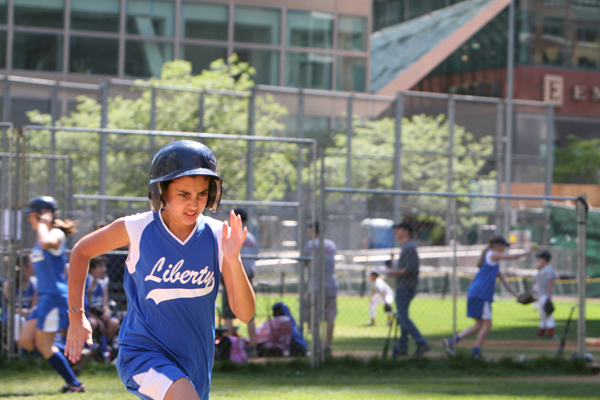BY Michael Mandelkern
They use a green ball and pitch underhand but have are as passionate as those who throw the original red-stitched ball associated with the All-American pastime. Girls’ softball in the Downtown Little League (DLL) is no casual picnic game, and is proving to be a competitive sport no longer taken lightly.
“Women in sports have always taken a second seat to the boys,” admitted Joe Marino, who has been coaching softball since 2006. He now coordinates the senior league, ages 13 to 17, and sits on the DLL board. “But they can be as good as the boys.”
Every team in the senior division remains undefeated this season and the junior league, comprised of 13 and 14 year-olds, is steadily improving its record.
Softball has been a part of the DLL since 2001, but in the beginning teams only played within their own league. And while softball became competitive in 2006 the “girls weren’t getting the training and pitching opportunities they needed,” said Marino in reference to the teams’ grueling 9-month season of practice and play.
He noted a senior league game, girls ages 13 to 17, four years ago when a Harlem roster crushed the DLL team 50-0. According to Marino, Harlem parents did not take downtown softball seriously then and other leagues dismissed their credibility.
Last year, the senior league advanced to the finals for the first time in its competitive history since it began playing teams outside of the DLL four years ago. “Everyone is committed and makes softball a priority,” Marino said.
“The level of play has just improved dramatically from last year,” said Tom Merrill, president of the DLL. “I think there will be more teams and more competition,” he added, hoping the older girls in the 9-to-12 year-old league will become as ambitious as the younger boys baseball teams.
His sentiments were on display at a game last Saturday. On a beaming sunny day, the Liberty played against the Powder Kegs, both part of the DLL, ages 9 to 12. Parents could be seen coaching on the field and cheering from the bleachers with passion.
Shouts of “good eye” and “you can drive it” rang out from the bleachers. Teams chanted for their batters from the dugout, singing, “We want a double, just a little double.”
Although a friendly game, the pitchers wound up with authority and some batters smacked balls to the outfield. Players were as grown as teenagers while the youngest girls scurried to keep up.
But the coaches and parents didn’t fret when a player struck out or missed a catch. Parents roared with just as much enthusiasm for both hits and misses. Rather than scold, coaches patted players on the back with a smile when the youngsters pouted on their way into the dugout in disappointment.
Jill Ostergaard, softball coordinator for 9-to-12 year-olds since three months ago, has been central to her age group’s success by organizing practices and tryouts and placing more emphasis on skill building.
She also groups teams by rank, a departure from what she describes as the “fairly loose” criteria of the past. Now teams of all age divisions wear uniforms and receive local sponsorship. There will also be an 11-to-12 year-old division to face other leagues, which will play its first game outside of the DLL on Sunday.
They were able to continue through the winter once Abby Ehrlich, Director of Programming of the Battery Park City Parks Conservancy, who oversees the parks between Pier A and Chambers Street, offered girls softball a permit to practice at a gym in Stuyvesant High School’s community center, located on Chambers Street.
“We want to keep supporting the youth,” she said, specifically noting what she perceives as the difficulty females have in getting space to play sports.
This past winter, varsity athletes from St. John’s University’s Division I softball team gave pointers to the 9-to-12 year-old players. As the youngest division in its league, their early devotion could translate into a commitment throughout high school and beyond.
“The skills the girls develop and their love of the game can be carried forward into college either at the inter-collegiate or club level,” wrote Bruce Rauffenbart, father of Caroline Rauffenbart, who plays in the senior league, via e-mail. He used to assist coaches but is now a spectator at his daughter’s games.
Caroline Rauffenbart, 16, has played in the DLL since 2000. She was the only female on an all-boys baseball team until she joined softball at age 10. She felt discriminated against while with the boys.
“Although I proved myself just as capable as the boys on my team, I was hardly given any playing time because I was a girl…until I began to play softball,” she wrote via e-mail. She crossed over to softball that same year.
She now attends Bard High School Early College, which does not offer the sport. “Having a team to play on in my neighborhood is convenient and also a great break from the grind of school,” wrote Rauffenbart.
The combination of tenacity from the girls and parental involvement has not only improved the players’ technique but also provided structure to the girls’ lives, according to a parent.
“I’m a huge supporter of team sports for girls,” said Kelly McGowan, who has been coaching in the DLL for the past ten years but currently not softball.
He believes the camaraderie between them translates to constructive relationships off the field and having a positive image of their bodies.
“The confidence they develop will last them a lifetime,” McGowan said, who has a 16-year-old daughter, Sarah McGowan, who plays for the senior league.
“These are important years … my goal is that they return next year.”

































